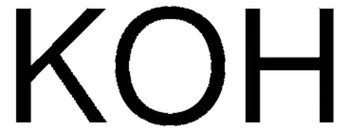Description
Potassium hydroxide
technical, ≥85%, powder
Synonym(s):
Caustic potash
Linear Formula:
KOH
CAS Number:
1310-58-3
Molecular Weight:
56.11
EC Number:
215-181-3
MDL number:
MFCD00003553
eCl@ss:
38100303
PubChem Substance ID:
329748211
NACRES:
NA.21
PROPERTIES
vapor pressure
1 mmHg ( 719 °C)
Quality Level
200
grade
technical
Assay
≥85%
form
powder
impurities
≤0.002% heavy metals (as Pb)
≤1.0% K2CO3
pH
~13.5 (25 °C, 5.6 g/L)
mp
361 °C (lit.)
anion traces
chloride (Cl-): ≤1000 mg/kg
sulfate (SO42-): ≤50 mg/kg
cation traces
Fe: ≤20 mg/kg
SMILES string
[OH-].[K+]
InChI
1S/K.H2O/h;1H2/q+1;/p-1
InChI key
KWYUFKZDYYNOTN-UHFFFAOYSA-M
General description
Potassium hydroxide is an inorganic compound with the chemical formula KOH. It is a strong base and is commonly known as caustic potash. Caustic potash is mainly used for making potassium salts, acid-base titrations, and organic synthesis. Furthermore, KOH can be used as an electrolyte in some fuel cells and alkaline batteries. Potassium hydroxide readily reacts with acids. It is used in various reactions such as nucleophilic, addition, and basic hydrolysis reactions. Additionally, it is employed as a catalyst for aldol-type reactions.
Application
Potassium hydroxide can be used:
- To prepare KOH treated powder activated carbon, which is used as a catalyst for the synthesis of CNT (carbon nano tube) using chemical vapor deposition (CVD) method.
- As a base in the intramolecular N-arylation of urea′s to form benzimidazol-2-ones.
- As a catalyst for the synthesis of khellactone-type compounds (10-aryl substituted-9,10-dihydropyrano[2,3-h] benzopyrone-8-ones) via one-pot, three-component (Meldrum′s acid, aryl aldehydes and 5,7-dihydroxy benzopyrone derivatives) reaction.
SAFETY INFORMATION
Pictograms
GHS05,GHS07
Signal Word
Danger
Hazard Statements
H290 - H302 - H314
Precautionary Statements
P234 - P260 - P280 - P301 + P312 - P303 + P361 + P353 - P305 + P351 + P338
Hazard Classifications
Acute Tox. 4 Oral - Eye Dam. 1 - Met. Corr. 1 - Skin Corr. 1A
Storage Class Code
8A - Combustible, corrosive hazardous materials
WGK
WGK 1
Flash Point(F)
Not applicable
Flash Point(C)
Not applicable





